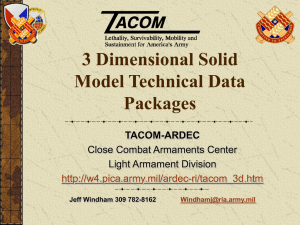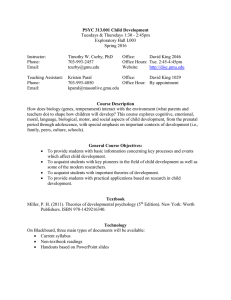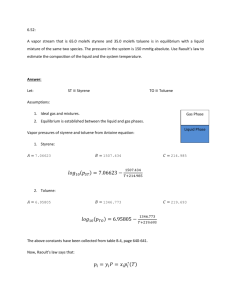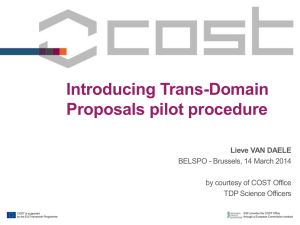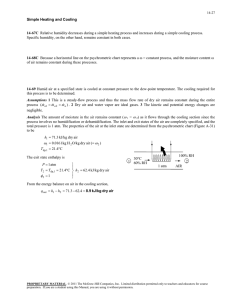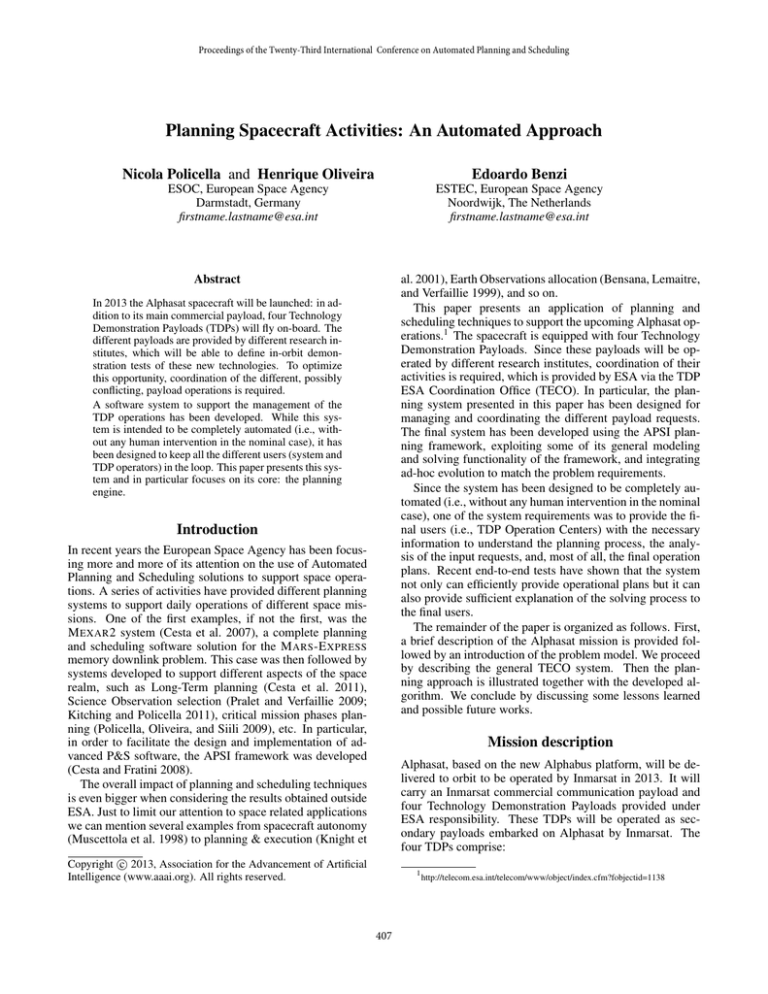
Proceedings of the Twenty-Third International Conference on Automated Planning and Scheduling
Planning Spacecraft Activities: An Automated Approach
Nicola Policella and Henrique Oliveira
Edoardo Benzi
ESOC, European Space Agency
Darmstadt, Germany
firstname.lastname@esa.int
ESTEC, European Space Agency
Noordwijk, The Netherlands
firstname.lastname@esa.int
Abstract
al. 2001), Earth Observations allocation (Bensana, Lemaitre,
and Verfaillie 1999), and so on.
This paper presents an application of planning and
scheduling techniques to support the upcoming Alphasat operations.1 The spacecraft is equipped with four Technology
Demonstration Payloads. Since these payloads will be operated by different research institutes, coordination of their
activities is required, which is provided by ESA via the TDP
ESA Coordination Office (TECO). In particular, the planning system presented in this paper has been designed for
managing and coordinating the different payload requests.
The final system has been developed using the APSI planning framework, exploiting some of its general modeling
and solving functionality of the framework, and integrating
ad-hoc evolution to match the problem requirements.
Since the system has been designed to be completely automated (i.e., without any human intervention in the nominal
case), one of the system requirements was to provide the final users (i.e., TDP Operation Centers) with the necessary
information to understand the planning process, the analysis of the input requests, and, most of all, the final operation
plans. Recent end-to-end tests have shown that the system
not only can efficiently provide operational plans but it can
also provide sufficient explanation of the solving process to
the final users.
The remainder of the paper is organized as follows. First,
a brief description of the Alphasat mission is provided followed by an introduction of the problem model. We proceed
by describing the general TECO system. Then the planning approach is illustrated together with the developed algorithm. We conclude by discussing some lessons learned
and possible future works.
In 2013 the Alphasat spacecraft will be launched: in addition to its main commercial payload, four Technology
Demonstration Payloads (TDPs) will fly on-board. The
different payloads are provided by different research institutes, which will be able to define in-orbit demonstration tests of these new technologies. To optimize
this opportunity, coordination of the different, possibly
conflicting, payload operations is required.
A software system to support the management of the
TDP operations has been developed. While this system is intended to be completely automated (i.e., without any human intervention in the nominal case), it has
been designed to keep all the different users (system and
TDP operators) in the loop. This paper presents this system and in particular focuses on its core: the planning
engine.
Introduction
In recent years the European Space Agency has been focusing more and more of its attention on the use of Automated
Planning and Scheduling solutions to support space operations. A series of activities have provided different planning
systems to support daily operations of different space missions. One of the first examples, if not the first, was the
M EXAR 2 system (Cesta et al. 2007), a complete planning
and scheduling software solution for the M ARS -E XPRESS
memory downlink problem. This case was then followed by
systems developed to support different aspects of the space
realm, such as Long-Term planning (Cesta et al. 2011),
Science Observation selection (Pralet and Verfaillie 2009;
Kitching and Policella 2011), critical mission phases planning (Policella, Oliveira, and Siili 2009), etc. In particular,
in order to facilitate the design and implementation of advanced P&S software, the APSI framework was developed
(Cesta and Fratini 2008).
The overall impact of planning and scheduling techniques
is even bigger when considering the results obtained outside
ESA. Just to limit our attention to space related applications
we can mention several examples from spacecraft autonomy
(Muscettola et al. 1998) to planning & execution (Knight et
Mission description
Alphasat, based on the new Alphabus platform, will be delivered to orbit to be operated by Inmarsat in 2013. It will
carry an Inmarsat commercial communication payload and
four Technology Demonstration Payloads provided under
ESA responsibility. These TDPs will be operated as secondary payloads embarked on Alphasat by Inmarsat. The
four TDPs comprise:
c 2013, Association for the Advancement of Artificial
Copyright Intelligence (www.aaai.org). All rights reserved.
1
407
http://telecom.esa.int/telecom/www/object/index.cfm?fobjectid=1138
TECO: the TDP ESA Coordination Office
As mentioned before an important role in the Alphasat Mission planning phase is played by the TDP ESA Coordination
Office (TECO). This office has been set-up with two main
objectives:
• TDPs Activities Coordination and Planning support – this
includes: collection of activities requests from TDP-OCs;
identification and resolution of possible TDP operation
conflicts (w.r.t. both the platform resources and between
TDPs); transmission to Inmarsat of the consolidated activity requests; reception from Inmarsat of activity execution
confirmation.
• TDPs telemetry reception and archiving – this includes:
reception and archiving of real-time telemetry stream;
collection and archiving of the different planning files;
providing historical data to the different TDP-OCs.
Figure 1: Overall planning interfaces
• An advanced Laser Communication Terminal to demonstrate GEO to LEO communication links at 1064nm;
By exploiting advanced planning and scheduling technologies, the planning system has been designed to have a relatively high degree of autonomy. The goal is to have the
consolidated activity plans generated automatically and all
input and output retrieved automatically. Only in the case
of anomaly is the TECO operator notified and required to
intervene.
• A Q-V Band communications experiment to assess the
feasibility of these bands for future commercial applications;
• An advanced Star Tracker with active pixel detector;
• An environment effects facility to monitor the GEO radiation environment and its effects on electronic components
and sensors.
Mission Planning Requirements
In this section we describe the Mission Planning Cycle, with
a focus on the role of the TDP ESA Coordination Office.
This planning cycle spans a period of a week. Each week,
on day 7 by 16:00 UTC, Inmarsat makes available to TECO
the TDP Activity Planning File (TAPF) containing the relevant spacecraft states and TDP operations availability windows. The different spacecraft states may have different limitations on TDP operations. A distinction can be made between those periods where TDPs could experience reduced
performance (e.g. maneuvers), where no TDP related commanding activities are permitted, and where limitations exist
on TDP modes.
Based on the above input, every week, on day 1 of the
next cycle (by 12:00 UTC ), TECO provides a TDP Activity
Request File (TARF) to Inmarsat covering 7 days of TDP
operations requests.
From the previous description is possible to identify the
following three steps (see Fig. 2):
For each TDP a dedicated operations center (TDP-OC) will
be responsible for defining and requesting the different payload experiments. The spacecraft resources (e.g., power),
downlink data, and telemetry budget, and therefore experiment execution, are shared between the TDPs, while operational requests are managed at a top level by the TDP ESA
Coordination Office (TECO).
The operations concept of the TDPs is broadly based
around a weekly planning cycle, with data exchange over
the Internet (see Fig. 1). Every week, the TDP ESA Coordination Office will provide conflict-free TDP operations
requests based on:
• The available windows for TDP operations;
• The Activity request files provided by each TDP-OC.
These operations requests are assumed to be ready in time
and in the proper format to be directly ingested into the Alphasat weekly schedule.
It is worth remarking that the role of Inmarsat is limited
to simply executing the operations which are driven entirely
by the inputs and supplementary information received from
ESA (e.g. consolidated TDP operations requests and schedule) and TDP-OCs (e.g. procedure parameters). No TDP
operations engineering activities are performed by Inmarsat,
i.e. no TDP contingency recovery actions are defined, and
no analysis of TDP performance or health are performed by
Inmarsat. In other words, TDP operation requests with conflicts will simply be rejected by Inmarsat and not included
in the spacecraft activity schedule.
a. Distribution of Inmarsat input: windows availability and
spacecraft status;
b. Generation of the TDP operation plan based on input requests provided by TDP-OCs;
c. Distribution of the final TDP operation plan.
The second step justifies the presence of the TECO system in
general, and its planning functionality in particular. In fact,
the core phase of the TECO workflow is the allocation of the
TDP requests. This in fact entails different aspects such as:
TDP requests analysis, exploitation of available time windows for TDP activities, platform resource limitations (e.g.,
TM bandwidth), interdependence between TDP modes and
408
(a)
(b)
Figure 3: TDP model example.
represents, at each time, the status of the payload. To represent the valid states that the TDP can assume over time, each
payload can be seen as a finite state machine, i.e., a TDP can
be in a finite number of states (here also named sub-modes):
• a finite, non-empty set of states, S
• a transition function δ : S × S → T, F , which specifies
for each couple Si , Sj if the transition from Si to Sj is
allowed.
Fig. 3 shows an oriented graph representing a TDP which
has five different states, the nodes. The ordered edges represent the valid transitions between two nodes/states.
(c)
Figure 2: Planning workflow.
/or activities, TDPs operations constraints, and TDP allocation policy/priority.
In particular an iterative construction of conflict free plans
(see Fig. 2(b)) is required; this approach gives the endusers (i.e., the TDP-OCs) the possibility to modify their unplanned requests. The current workflow foresees three different iterations:
Spacecraft status and opportunity windows. Another
relevant aspect that has to be modeled is the spacecraft status
together with the opportunity windows for TDP operations.
The information provided can be seen as a list of triples:
• st, the start time of the interval
• et, the end time of the interval
• type, the characterization of the interval. This can be one
of the following:
– Spacecraft Availability – during this interval, the Inmarsat ground segment is available to execute TDP activities.
– No Ground Availability – during this interval, no activity can be executed from ground, i.e., no procedures
(associated to any TDP activity) can be executed from
the ground control center. However it is still possible
to execute on-board procedures (which of course have
to be uploaded in advance).
– No TDP Activity – during this interval, no activity can
be executed (neither on-ground nor on-board). The different TDPs will maintain their state through the interval.
– TDPs OFF – the TDP are requested to be off during this
interval. Not only no activities can be executed during
this interval, but it is also required to each TDP-OC, to
allocate the necessary activities to properly switch off
the TDPs.
– Maneuvers – as the different satellite maneuvers can
affect some of the TDP activities, this information is
provided to avoid their execution
• TDP-OCs submit their input requests. TECO also produces a plan based on preliminary versions of the spacecraft availability plan. Feedback is sent to the TDP-OCs
in case some of their requested activities are not allocated.
• TDP-OCs submit their updated input requests. TECO
produces a plan based this time on the final version of
the spacecraft availability plan (sent by Inmarsat). Also at
this step, feedback is sent to the TDP-OCs in case some
of their requested activities are not allocated.
• TDP-OCs submit their final input requests. TECO produces a final plan and distributes it to Inmarsat (that will
execute it) and to the TDP-OCs.
The goal of this iterative approach is to maximize the operation requests allocation of the different TDPs, while the
workflow foresees having a maximum time interval of 20
minutes between the reception of the input files and the
sending of the plan.
Domain Model
This section introduces a timeline based representation of
the problem (Chien et al. 2012).
TDP model. The central concept of the mission as described before is the presence of the different Technology
Demonstration Payloads, or TDPs. For what concerns the
planning problem, each TDP can be seen as a timeline which
409
As it is necessary to distinguish between ground control
commanding and on-board only execution of tasks (see below), the spacecraft status is modeled by two timelines representing respectively the status of the ground and the spacecraft segment.
Task requests. A task request consists of a set of commands that refer to a specific payload (TDP). These commands either have to be executed from the ground control
or can automatically be executed on-board without ground
control intervention. As each of the commands can modify
the status (sub-mode) of the payload, for what concerns our
model, we associated a task to an ordered sequence, without
temporal gaps, of sub-tasks (the reader can see each sub-task
associated to a command or group of commands). Formally
a task ti is defined by the following set:
• A time interval [lbti , ubti ] defining the feasibility interval
where the task request can be allocated;
• The associated payload or TDP, tdpti ;
Figure 4: Task model example.
• A weight value, wti ;
• An ordered sequence of sub-tasks STti
=
{st0,ti , . . . , stnti ,ti }, where each sub-task is defined
by:
–
–
–
–
instance in case the payloads are switched off, it is required that a TDP x is moved to the “off” status, that is,
TDPs OFF DURING x.OF F .
• Constraints between two task requests. These require that
the associated tasks are either both allocated or not. The
constraint can also require a minimum and/or maximum
time separation between the execution of the two tasks.
• Resource Constraints.
This represents the minimum/maximum availability of each resource. In the
model, we consider both power and data-downlink usage.
The duration, dst0,ti
The sub-mode value, smst0,ti
The bandwidth usage, bwst0,ti
The power usage, , pwst0,ti
• A Boolean variable that indicates if a task is on-board only
(value true) or if the task has to be executed both on-board
and on-ground (value false) obti .
Problem. Given the above definitions, a problem is composed by:
• A set of task requests, T asks;
• A set of initial states, one for each TDP, Init;
• A set of constraints, Constraints;
• A set of time intervals representing the spacecraft availability and status, Spacecraf t;
Fig. 4 shows a task example. It is worth considering that
with respect to the timelines associated to both the ground
control and the satellite status, a task can be seen as a unique
entity. This does not apply to the TDP timeline; in fact, in
this case it is necessary to have detailed information about
the requested states of the TDP (i.e., the list of sub-modes).
The same applies when resources are considered as resource
consumption is also associated to TDP states.
Another aspect not represented in Fig. 4, but considered
in the design of the solving approach, is that at the end of
each task execution, the TDP status, as well as power and
bandwidth usage, remain at the values specified from the last
sub-task (for the TDP this will be C in the case of the task
in Fig. 4). This aspect has to be considered, for instance, in
order to have a precise estimation of resource usage.
Solution. Given the initial problem (in particular the set
of task requests), a feasible solution S consists of the set
of allocated task requests, AllT asksS ⊆ T ask, where for
each task ti ∈ AllT asksS a start-time stti is specified and
all constraints as well as state variables are satisfied.
While the empty solution (i.e. AllT asksS0 = ∅) is a solution, the objective is to maximize the number of allocated
tasks. In particular the following weighted function shall be
maximized:
X
V alue(S) =
wti
Constraints. The final aspect that needs to be modelled is
the different types of constraints that can be defined in the
problem:
• Constraints between two different TDPs. This is the case
in which a TDP x, in order to be in a particular status
A, requires another TDP y to be in a particular status or
sub-mode B, that is, y.B DURING x.A.
ti ∈AllT asksS
Example. We conclude this section with an example to illustrate some of the aspects discussed before. For the sake
of simplicity, in the example we do not consider resource
constraints, and the initial states of the TDPs.
Fig. 5(a) represents a two TDPs problem with four tasks
T asks = {ta1 , ta2 , tb1 , tb2 } (two for each TDP) and two
• Constraints between a TDP and the status of the satellite.
This is the case in which a particular status of the satellite has to be supported by specific status of the TDP. For
410
Figure 6: TECO planning engine
Planning Approach
Figure 6 shows the high-level architectural design of the
TECO Planning Engine. The design is based on a common core for representing the domain knowledge. This is
based on the concept of timelines, i.e., a mathematical construct that contains temporally related items. Around this
core there are three different modules: an input provider, a
problem solving engine, and an output generator which includes an explanation service submodule.
The input provider has the goal of populating the internal representation by importing the problem domain and the
problem instance. The solving engine provides the capabilities to generate an activity plan. In particular, this can
consist on a portfolio of solving libraries. Last, the output
generator takes the internal representation of the final activity plan and transforms it into a requested format. This
format can be for instance a specific file and/or a graphical
representation of the plan. Below, we discuss a fundamental
requirement of this phase, the need for complementing the
final solution with sufficient information (or explanation) to
let the final user (a human being or software system) understand the decisions taken during the solving process.
(a) Initial requests.
(b) Solution.
Figure 5: Example.
constraints, T DP a.W during T DP b.A and tb1 < tb2 +10.
For what concerns the spacecraft availability there are two
intervals in which the spacecraft is not available, the first
only for on-ground commanding, the second for both onground and on-board execution (see the last two timelines in
Fig. 5(a)). For each task the figure shows also the feasibility
windows and the associated sub-task (see TDP timelines).
Fig. 5(b) shows an optimal solution to the problem. First
the reader can notice that, even though ta1 could be allocated earlier (in fact is an on-board only task), it is allocated after tb1 . This is justified by the first constraint,
T DP a.W during T DP b.A. At the end of the execution of
tb1 , T DP b remains in the status T DP b.A that is required to
move T DP a in T DP a.W , and the execution of ta1 .
Second, as the two tasks, tb2 and ta2 , are conflicting only
one is allocated: tb2 . In fact the latter is also linked to
tb1 which requires that both the tasks are executed together.
Therefore tb2 is chosen with respect to ta2 as it maximize
the objective function. The final solution is AllT asks =
{ta1 , tb1 , tb2 }.
Figure 7: The general architecture of the A PSI - TRF environment
The A PSI framework
The TECO planning engine has been developed as a plug-in
for the A PSI framework (Cesta and Fratini 2008) or A PSI TRF . The framework design (Fig. 7) inherits from previous literature of timeline-based systems (Jonsson et al. 2000;
Chien et al. 2000) and from the work in developing a general purpose planning and scheduling system called O MPS
(Fratini, Pecora, and Cesta 2008). The A PSI - TRF supports
411
Algorithm 1 shows the resulting approach: given a problem P which has the associated set of tasks T asksP , Algorithm 1 is initialized with the queue Q = {P } (where
AlltasksP = T asksP ) and the initial best solution Sempty
(where AlltasksSempty = ∅).
the rapid prototyping of planning tools through different
functionalities. The A PSI - TRF unifies timelines of different nature under the unique concept of component, where
each component is an entity with a set of possible temporal
evolutions over a planning temporal horizon – in general a
component may have one or more associated timelines. The
A PSI - TRF allows representing the temporal evolution of the
components as well as the constraints that affect their temporal evolution. Each component in the A PSI - TRF is a deductive system able to proactively propagate effects of external
decisions on the modeled segment of its temporal representation.
The development of the planning solution on top of the
A PSI framework makes the planning system easily extendable. This aspect was particularly relevant in the early phase
of the mission when the Alphasat operations concept was
still under definition/design.
For what concerns the actual implementation, two algorithms have been used among the ones currently available in
the A PSI framework: the O MPS planner (Cesta and Fratini
2008) and the I SES scheduling algorithm (Cesta, Oddi, and
Smith 2002). The planning algorithm is used, not only to
check the behavioral consistency of the requested task, but
also to complement the different tasks to obtain continuous
timelines. In fact, an activity/task has to be added between
two consecutive allocated tasks in order to model the continuous usage of the resources as well as the status of the
payload. These activities are considered in the scheduling
phase in order to have a consistent usage of the resources.
On the other side, as the set of task requests is fixed in input,
the planner’s capabilities are exploited only in a limited way.
Knowledge Representation Module
This module allows representing the evolution of the solving
process from the initial problem to the final solution(s). Following a consolidated trend in space applications (Chien et
al. 2012), the representation is based on the concept of timelines, where each timeline represents the temporal evolution
of one particular aspect (e.g., spacecraft utilization, ground
segment utilization, and payload(s) status). The goals (that
can be seen as a specific behavior of one or more timelines
over a specific time interval) and the constraints (among the
behaviors of two or more timelines) are used to represent the
initial problem.
During the solving process different decisions are taken.
Each solving decision consists of:
As mentioned before, during the solving process all the
decisions taken are labeled with the originator of the decision and the motivation of the decision. For this reason
the A PSI planning and scheduling algorithms have been redesigned to return, for instance, the set of unsolvable conflicts (these sets will be empty in case the solving process
is successful). This information is then used to identify the
next steps of the search: the branching method considers in
fact not only the initial candidate solution, s0 , but also the set
of unsolvable conflicts that makes this candidate unfeasible.
The latter is used to generate the next branches.
• a type: for instance, posted constraint, posted activity, removed goal, or removed constraint.
Algorithm 1: BranchNBound (Q, Sbest )
Input: Queue of possible solutions Q and current best
solution Sbest
Output: An optimal solution S
while Q 6= ∅ do
s0 ← ExtractCandidateSolution (Q)
if UpperBound (s0 )> Value (Sbest ) then
Cp ← planner (s0 )
if Cp = ∅ then
// a plan for s0 exists
Cs ← scheduler (s0 )
if Cs = ∅ then
// a schedule for s0 exists
if Value (s0 )>Value (Sbest ) then
// update best solution
Sbest ← s0
• a decision generator: “who” generated the decision
• a decision reason: “why” the decision was taken
The last two points have been introduced in order to coordinate different solving libraries and to support the generation
of explanations. In the remainder of the section we discuss
both these aspects.
Solving Approach
Two solving approaches have been considered in order to
cope with the two different types of component present in
the problem domain: state variable timelines (used to represent the different TDPs) and re-usable resources (i.e., ground
control availability, satellite availability, power, and bandwidth usage). These two approaches have been merged into
a meta-schema based on a branch-and-bound algorithm:
if Cp 6= ∅ or Cs 6= ∅ then
Qnext ← branching (s0 , Cp, Cs)
snext = BranchNBound (Qnext , Sbest )
if Value (snext )>Value (Sbest ) then
// update best solution
Sbest ← snext
• At a high level, a planner allocates the different tasks on
the state-variable timelines. The goal of this phase is to
generate a consistent behavior for each one of the statevariables representing the TDPs.
Q = Q −{s0 }
return Sbest
• At a low level, a scheduler, given a solution of the planner
in input, generates a feasible solution with respect to both
the re-usable resources and the temporal constraints.
412
Explanation
A relevant aspect of the output generation process is the need
for providing sufficient explanation about the solving process. This is even more important in the case of TECO as the
system has been designed to be completely automated, i.e.,
it should run without any human intervention in the nominal
case.
When we talk about sufficient explanation, our objective
is to provide the system users (i.e., TDP-OCs and TECO
operators) with the necessary information to understand the
decisions taken during the solving process and the final operation plans.
In the context of the TECO operations, a proper explanation is also needed to have effective iterations between TDPOCs and TECO. Considering that the time available to the
TDP-OCs to provide a new set of task requests is limited,
it becomes fundamental to provide, for instance, the right
explanation on why a task was not allocated.
To achieve these objectives, our approach is based on the
following points:
(a) Planning decision and scheduling conflict
(b) Planning conflict
1. A “protocol.” This is used to exchange information between TDP-OCs and TECO. This protocol has been introduced to address differences in backgrounds among the
different partners. In fact, while the TDP-OCs are experts
in their specific payload , they are not required to be experts in advanced planning and scheduling technologies.
Figure 8: Example of explanations
platform activity “TDPs OFF.” In this case the explanation
process will need to consider both 1) the planner conflict and
2) the domain theory.
From the previous examples it is possible to notice that
for providing correct explanation it is necessary to consider
all the decisions coming from the different solvers. Even if
they represent very basic cases, the examples are also useful
to give an idea of the effort needed to retrieve proper information especially when considering more complex and real
cases, with more activities, resources, constraints, etc.
The approach implemented to generate explanations consists in “tracing back” all the different solving decisions that
are associated to a task request. This is done by exploiting the different annotations added during the solving process. Once all this information is collected, the explanation
generator module identifies the specific case based both on
the solvers which generate the annotations (for instance the
scheduler) and on the content of the annotations (e.g., conflict with spacecraft activity).
This modular approach used for generation of explanations has also been chosen to facilitate future re-usability
and evolution. For instance this can be the case of a different
type of user accessing the TECO system (e.g., web-client)
which can require a different protocol, or the possibility of
modifying the set of solvers.
2. “Labelled decisions.” All solving decisions are labeled
with information about the solver who takes the decision
and with the motivation of the decision.
3. An “Explanation Generator” module. The goal of this
module is to interpret the information provided together
with the solving decisions and of generating information
for the system users by applying the given protocol.
A first aspect worthy of attention is that with this approach
the final explanation is not generated directly by the different solvers. This is required as 1) the solvers can only have
a limited view of the current situation and 2) to allow decoupling the set of used solvers from the final explanation
generation process (and the associated protocol). Figure 8
shows two simple examples in which a task cannot be allocated. In both cases the explanation cannot be provided
directly by a single solver. In the first one there are two task
requests with a constraint which requires that the status W
(during ta ) shall be executed while the payload T DPb is in
the status A. In this case tb will not be allocated. In fact to
satisfy the previous constraint the planner will add the solving decision et(tb ) ≤ st(ta ) and pass it to the scheduler.
The scheduler will then fail as tb cannot be scheduled before the start of ta due to the presence of the “not available”
constraint. In generating the explanation for the missing allocation of ta it will then be necessary to consider not only
1) the conflict identified by the scheduler but also 2) the decision taken by the planner, and 3) the domain theory.
A second example is shown in Fig. 8(b) with only one task
request ta . In this case, while the task could be allocated in
a time window, the planner will find a conflict between the
final status of the task (X) and the value requested by the
Further Engineering issues. We conclude this section by
highlighting some key aspects that have driven both the design of the solving approach and the overall planning cycle.
A first aspect is how the use of planning and scheduling approaches allowed us to suggest and then introduce a
change in the original workflow. In fact, the initial workflow did not foresee any iterations between TECO and the
413
main characteristics of the future system. In the current state
of the art, we noticed that despite their possible role in the
introduction of advanced planning and scheduling solutions
to real domains, there are not many examples of these environments.
different TDPs. The short solving time permits, in the case
of unresolved conflict between the TDPs specific requests,
to optimize the set of task requests via an iterative process
between the TDP-OCs and TECO. Even though multiple iterations can be possible, the human operator was also considered carefully in order to design the final planning cycle
(e.g., TDP-OC operators might need time to evaluate their
decisions). From this analysis a limit of three iterations was
agreed. This was a compromise between the software system’s capabilities (e.g., solving approach), the goals (e.g.,
TDP-OCs operators), and the information availability (for
instance the final satellite status timeline is only available
for the last two iterations while in the first one only an estimation is used).
Besides the computational capability, another characteristic of the solving algorithm suggested a re-definition of the
operations. Both the planner and the scheduler have as a
core a temporal representation of the problem which allows
it to efficiently manage temporal aspects of a planning and
scheduling problem. To exploit this capability and optimize
the result of each iteration, temporal flexibility has been introduced in the task requests (instead of having fixed starttime task requests as originally designed).
Conclusions and Future work
The paper presented the automated planning and scheduling software system that has been designed to support the
operations of the four Technology Demonstration Payloads
(TDPs) that will fly on-board the Alphasat spacecraft. The
TECO system will be operational in 2013 and will automatically coordinate and plan the task requests for these payloads.
At this stage the TECO system has been completely developed. During the development, the system has been intensively tested with several artificial problem benchmarks
with the number of task requests ranging from few tens to
hundreds (over a week time horizon). More recently the
system has been validated in end-to-end test sessions with
realistic task requests provided by the different TDP-OCs.
Different cases have been tested, such as nominal cases, resource conflicting requests, and TDP modes inconsistent requests. These tests have shown that the TECO system can
return a solution in the given time bound (20 minutes), is robust towards non-nominal cases, and can provide sufficient
explanations to the TDP-OC operators.
Future work will aim at further evolving the current solving approach, in different directions. The first one consists
of extending the approach to generate robust and/or flexible solutions which can better support the actual execution
of the plan. For instance one of the first steps is to substitute the current scheduling algorithm with approaches able
to produce flexible schedules instead of fixed-time solutions
(Policella et al. 2009).
A second direction is to extend the quality of the feedback provided to the TDP-OCs operators, by adding to the
current explanations possible suggestions on how to fix the
unsuccessful task requests. The idea is to use in particular planning capabilities to identify reallocation of the tasks
and/or new tasks to be added. This information can then be
provided to the TDP-OC operators which must then validate
and approve it.
A further possibility would be to extend the current solving process to minimize the differences among the different
solutions produced during the iteration phase (see Fig. 2(b)).
Here the results obtained in the case of Minimal Perturbation problems could be re-applied (El Sakkout, Richards,
and Wallace 1998).
From a more general viewpoint, we would like to further investigate the possibility of using “explanation” as a
means to facilitate the integration of planning and scheduling solvers. In our approach, we noticed in fact as sharing
adequate information among the different solvers improved
the overall solving process. In future work we plan to generalize this approach and include it in the A PSI framework.
Lessons Learned
In this section we summarize some of the lessons learned
during the design and development of the TECO system.
Some of these points can also be considered as directions
for future research work.
As mentioned before, even though at that time, the mission operations workflow was almost completely defined,
we were able to convince our partners to modify the workflow and introduce iterations between TDP-OCs and TECO.
The key aspect here was the efficiency of the solving algorithms together with the possibility to provide feedback to
the TDP-OC operators with ad-hoc explanations of the solving process. This feedback becomes fundamental when an
automated planning system is in place.
Another fundamental decision in our experience was to
have a flexible architectural design of the system which allowed us to cope with the several changes experienced in
the definition of the problem. This point is connected with
the availability of a software framework (A PSI - TRF), and its
modeling ability, which enables us to both connect specialized or general solvers developed outside the framework and
develop specialized interaction services. In fact, a key aspect
of A PSI - TRF is the presence of a flexible timeline representation module that allows exploiting alternatives in the modeling of mission features as well as developing and testing
different algorithms (Cesta et al. 2009).
Something that we found missing during our experience
was a Knowledge Engineering Environment for supporting
the development of planning systems, which would enable a
rapid prototyping approach. This type of tools allows creating a working model after a relatively short investigation by
taking advantage of the speed with which this model can be
implemented via the KE environment. This is fundamental
to provide to the developers the basic functionalities to satisfy the model requirements and to show the end-users the
414
Acknowledgments
Chien, S.; Johnston, M.; Frank, J.; Giuliano, M.; Kavelaars,
A.; Lenzen, C.; and Policella, N. 2012. A generalized
timeline representation, services, and interface for automating space mission operations. In Proceedings of the 12th
International Conference on Space Operations, SpaceOps.
AIAA.
El Sakkout, H.; Richards, T.; and Wallace, M. 1998. Minimal Perturbation in Dynamic Scheduling. In ECAI-98. Proceedings of the 13th European Conference on Artificial Intelligence, 504–508.
Fratini, S.; Pecora, F.; and Cesta, A. 2008. Unifying Planning and Scheduling as Timelines in a Component-Based
Perspective. Archives of Control Sciences 18(2):231–271.
Jonsson, A.; Morris, P.; Muscettola, N.; Rajan, K.; and
Smith, B. 2000. Planning in Interplanetary Space: Theory and Practice. In AIPS-00. Proceedings of the Fifth Int.
Conf. on Artificial Intelligence Planning and Scheduling.
Kitching, M., and Policella, N. 2011. A Local Search Solution for the INTEGRAL Long Term Planning. In Proceedings of the 7th International Workshop on Planning and
Scheduling for Space, IWPSS11.
Knight, R.; Rabideau, G.; Chien, S.; Engelhardt, B.; and
Sherwood, R. 2001. CASPER: Space Exploration through
Continuous Planning. IEEE Intelligent Systems 16(4):70–
75.
Muscettola, N.; Nayak, P. P.; Pell, B.; and Williams, B. C.
1998. Remote agent: To boldly go where no ai system has
gone before. Artificial Intelligence 103(1-2):5–47.
Policella, N.; Cesta, A.; Oddi; A.; and Smith, S. 2009.
Solve-and-Robustify. Synthesizing Partial Order Schedules
by Chaining. Journal of Scheduling 12(3):299–314.
Policella, N.; Oliveira, H.; and Siili, T. 2009. SKeyP: AI
applied to SOHO Keyhole Operations. In SMC-IT 2009.
Proceedings of the 3rd IEEE International Conference on
Space Mission Challenges for Information Technology.
Pralet, C., and Verfaillie, G. 2009. AIMS: A Tool for Longterm Planning of the ESA INTEGRAL Mission. In Proceedings of the 6th International Workshop on Planning and
Scheduling for Space, IWPSS09.
The authors would like to thank all the anonymous (and not)
reviewers which provided very useful comments to the paper. A special thank goes to our colleague Simone Fratini,
which supported us in the initial customization of the A PSI
framework.
References
Bensana, E.; Lemaitre, M.; and Verfaillie, G. 1999. Earth
Observation Satellite Management. Constraints: An International Journal 4(3):293–299.
Cesta, A., and Fratini, S. 2008. The Timeline Representation Framework as a Planning and Scheduling Software Development Environment. In PlanSIG-08. Proceedings of the
27th Workshop of the UK Planning and Scheduling Special
Interest Group.
Cesta, A.; Cortellessa, G.; Fratini, S.; Oddi, A.; and Policella, N. 2007. An innovative product for space mission
planning – an a posteriori evaluation. In ICAPS-07. Proceedings of the 17th International Conference on Automated
Planning & Scheduling, 57–64.
Cesta, A.; Fratini, S.; Donati, A.; Oliveira, H.; and Policella, N. 2009. Rapid Prototyping of Planning and Scheduling Tools. In SMC-IT 2009. Proceedings of the 3rd IEEE
International Conference on Space Mission Challenges for
Information Technology.
Cesta, A.; Cortellessa, G.; Fratini, S.; and Oddi, A. 2011.
MrSPOCK - Steps in developing an end-to-end space application. Computational Intelligence 27(1):83–102.
Cesta, A.; Oddi, A.; and Smith, S. F. 2002. A Constraintbased method for Project Scheduling with Time Windows.
Journal of Heuristics 8(1):109–136.
Chien, S.; Rabideau, G.; Knight, R.; Sherwood, R.; Engelhardt, B.; Mutz, D.; Estlin, T.; Smith, B.; Fisher, F.; Barrett,
T.; Stebbins, G.; and Tran, D. 2000. ASPEN - Automating
Space Mission Operations using Automated Planning and
Scheduling. In SpaceOps-00. Proceedings of the 6th International Conference on Space Operations.
415

